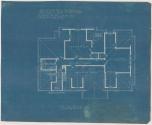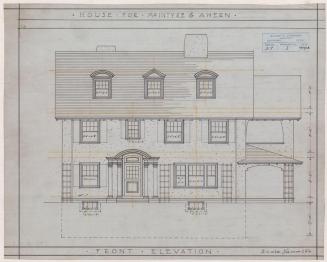House for Dr. J.W. Felty, 734 Prospect Avenue, Hartford
ArchitectDesigned by
Isaac Almarin Allen Jr.
(American, 1859 - 1953)
Dateearly 20th century
MediumBlueprints on paper
DimensionsPrimary Dimensions: 18 1/2 x 22 1/4in. (47 x 56.5cm)
ClassificationsGraphics
Credit LineConnecticut Museum of Culture and History collection
Object number2011.102.0.1-.14
DescriptionArchitectural plans for a two-and-a-half-story Colonial Revival frame house with strong Queen Anne infleunces. The home has a rough-cut stone foundation, modillion course, hipped roof, and dominant front-facing cross gable. There is a lower cross gable over a projecting two-story bay on the south (side) elevation and lower cross gable over a projecting one-and-a-half-story bay on the north (side) elevation. There are gabled dormers with cornice returns and arched windows on the north, south, and east (rear) elevations. The house is sheathed in wood shingles except for the first story of the facade and the western (front) half of the first story of the south elevation which are faced with rough-cut stone. There are tripartite windows with stone sills on the first story of the facade and three-sided bay windows above. Fenestration consists of a mix of detailed double-hung and casement windows and there is a large Palladian window in the front-facing gable. Windows have a variety of glazing patterns, including arched, lozenge, and circular arrangements.
The partial-width, one-story, wrap-around porch has a stone base, stone coping, turned spindle balustrade, paired Doric supports, wide entablature, and hipped roof. There is a one-story porch with Doric supports, modillion course, and hipped roof at the southeast corner of the house. The porch is enclosed with removeable arched glass panels. There is a one-story porte-cochere with Doric supports and hipped tin roof on the north elevation. The front entry door has an arched light and is flanked by multi-pane sidelights.
Fourteen drawings are included in the set; north, south, east, and west elevations; a transverse section; cellar, first-floor, second-floor, and attic plans; as well as five elevation and floor plan drawings for a one-and-a-half-story carriage house. The transverse section drawing includes details of the front cellar, an office waiting room, living room, dining room, bathroom, attic storage room, as well as the side porch and porte cochere. The cellar plan indicates range and heater coal rooms, a laundry room, doctor's office, and waiting room. The first-floor plan illustrates the front porch, living room, music room, reception room, library, dining room, kitchen, pantry, bulter's pantry, as well as the side and rear porches. The second-floor plan includes two chambers, a guest room, sitting room, "boy's room", hall, upper hall, two bathrooms, various closets, and an open well staircase. The attic plan indicates a maid's room, chamber, maid's bathroom. hall, and an unfinished space.
Five drawings are included in the carriage house plans; combined front and south side elevations, rear and north side elevations; as well as foundation, first-floor, and second-floor plans. The elevation drawings illustrate a one-and-a-half-story cottage-style carriage house with a hip-on-gable roof. the carriage house is sheathed in wood shingles. There are two dormers on the facade and one on the rear (east) elevation. One of the front-facing dormers has a hipped roof with cross gable and the other is an inset dormer with gable roof. The rear dormer has a shed roof and three small hinged windows. Intricate fenestration can be found throughout. This includes a mix of arched casement, double-hung, and hinged windows. The carriage bay, front entry, and side doors have detailed wood paneling below and multi-pane windows above.
The carriage house foundation plan includes excavation, support pier, and section details of the substructure. The first-floor plan indicates a carriage room, wash stand, stable, three stalls, harness room, manure pit, closet, and wash sink. The second-floor plan has a hay loft with hay chutes and grain bins, as welll as a "man's room" with drum stove and closet.
The partial-width, one-story, wrap-around porch has a stone base, stone coping, turned spindle balustrade, paired Doric supports, wide entablature, and hipped roof. There is a one-story porch with Doric supports, modillion course, and hipped roof at the southeast corner of the house. The porch is enclosed with removeable arched glass panels. There is a one-story porte-cochere with Doric supports and hipped tin roof on the north elevation. The front entry door has an arched light and is flanked by multi-pane sidelights.
Fourteen drawings are included in the set; north, south, east, and west elevations; a transverse section; cellar, first-floor, second-floor, and attic plans; as well as five elevation and floor plan drawings for a one-and-a-half-story carriage house. The transverse section drawing includes details of the front cellar, an office waiting room, living room, dining room, bathroom, attic storage room, as well as the side porch and porte cochere. The cellar plan indicates range and heater coal rooms, a laundry room, doctor's office, and waiting room. The first-floor plan illustrates the front porch, living room, music room, reception room, library, dining room, kitchen, pantry, bulter's pantry, as well as the side and rear porches. The second-floor plan includes two chambers, a guest room, sitting room, "boy's room", hall, upper hall, two bathrooms, various closets, and an open well staircase. The attic plan indicates a maid's room, chamber, maid's bathroom. hall, and an unfinished space.
Five drawings are included in the carriage house plans; combined front and south side elevations, rear and north side elevations; as well as foundation, first-floor, and second-floor plans. The elevation drawings illustrate a one-and-a-half-story cottage-style carriage house with a hip-on-gable roof. the carriage house is sheathed in wood shingles. There are two dormers on the facade and one on the rear (east) elevation. One of the front-facing dormers has a hipped roof with cross gable and the other is an inset dormer with gable roof. The rear dormer has a shed roof and three small hinged windows. Intricate fenestration can be found throughout. This includes a mix of arched casement, double-hung, and hinged windows. The carriage bay, front entry, and side doors have detailed wood paneling below and multi-pane windows above.
The carriage house foundation plan includes excavation, support pier, and section details of the substructure. The first-floor plan indicates a carriage room, wash stand, stable, three stalls, harness room, manure pit, closet, and wash sink. The second-floor plan has a hay loft with hay chutes and grain bins, as welll as a "man's room" with drum stove and closet.
Collections
Status
Not on view


























